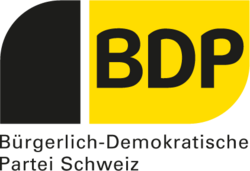
Back Bürgerlich-Demokratische Partei ALS Bürgerlich-Demokratische Partei German Partido Burgués Democrático Spanish Parti bourgeois-démocratique French Partito Borghese Democratico Italian スイス保守民主党 Japanese 스위스 보수민주당 Korean Börjerliche Demokratische Parteij van d Schweiz KSH Factio civilis democratica Helvetica Latin Burgerlijk-Democratische Partij Dutch
 | |
| President | Martin Landolt |
| Founded | 1 November 2008 |
| Dissolved | 31 December 2020 |
| Split from | Swiss People's Party |
| Merged into | The Centre |
| Headquarters | Postfach 119 CH-3000 Bern 6 |
| Membership (2015) | 6,500[1] |
| Ideology | Conservatism |
| Political position | Centre to centre-right |
| Colours | Yellow (official) Black (customary) |
The Conservative Democratic Party of Switzerland (German: Bürgerlich-Demokratische Partei Schweiz, BDP; French: Parti bourgeois démocratique suisse, PBD; Italian: Partito Borghese Democratico Svizzero, PBD; Romansh: , PBD; Swiss Democratic Bourgeois Party) was a conservative[2][3][4] political party in Switzerland from 2008 to 2020. After the 2019 federal election, the BDP had three members in the National Council.
It was founded as a moderate splinter group from the national-conservative Swiss People's Party (SVP/UDC); it was created as a political party on the federal level on 1 November 2008.[5] It was led by Martin Landolt. It had, until January 2016, one Federal Councillor, Eveline Widmer-Schlumpf, whose election in defiance of the SVP/UDC incumbent Christoph Blocher led to the creation of the party. It comprised most of the SVP/UDC's old centrist-agrarian wing, which had been overshadowed in recent years by its nationalist-activist wing.
The party's name in German, French, Italian and Romansh came from "bourgeois", the traditional European term for a centre-right party.
On 1 January 2021,[6] the party merged with the Christian Democratic People's Party (CVP/PDC) to form the new party The Centre (DM/LC).[7][8][9][10] Cantonal parties were allowed to continue operating under the existing BDP/PBD name.
- ^ Cite error: The named reference
chancellerywas invoked but never defined (see the help page). - ^ Nordsieck, Wolfram (2019). "Switzerland". Parties and Elections in Europe. Retrieved 9 November 2019.
- ^ Bale, Tim (2021). Riding the populist wave: Europe's mainstream right in crisis. Cristóbal Rovira Kaltwasser. Cambridge, United Kingdom: Cambridge University Press. p. 34. ISBN 978-1-009-00686-6. OCLC 1256593260.
- ^ Teuwsen, Peer (October 24, 2011). "In der Schweiz Tut Sich Was". Die Zeit. Retrieved April 19, 2016.
- ^ "Die BDP Schweiz wird am 1. November gegründet". Neue Zürcher Zeitung (in German). 30 August 2008. Retrieved 2 January 2022.
- ^ Europe Elects [@EuropeElects] (January 2, 2021). "Switzerland: Yesterday, CVP (EPP) and BDP (*) merged" (Tweet). Archived from the original on 2 January 2021. Retrieved 2 January 2022 – via Twitter.
- ^ "CVP schliesst sich mit BDP zur "Die Mitte" zusammen". Swissinfo (in German). 28 November 2020. Retrieved 2 January 2022.
- ^ "BDP-Delegierte sagen Ja zum Zusammenschluss mit der CVP". Suedostschweiz (in German). 14 November 2020. Retrieved 2 January 2022.
- ^ "CVP und BDP sind ab 2021 «Die Mitte»". Schweizer Bauer (in German). 29 November 2020. Retrieved 2 January 2022.
- ^ Wientzek, Olaf (1 December 2020). "Historic day for Swiss Christian Democrats – Merger and Farewell to the "C"". Konrad Adenauer Foundation. Retrieved 2 January 2022.